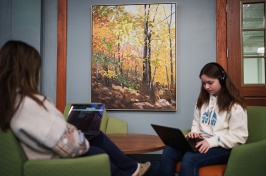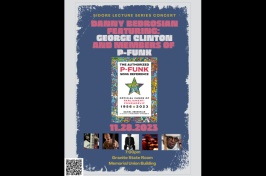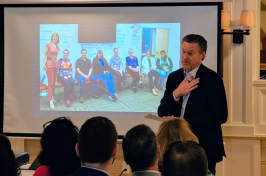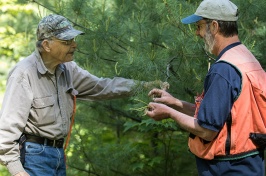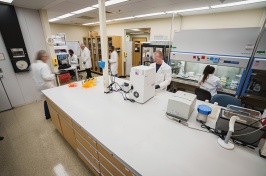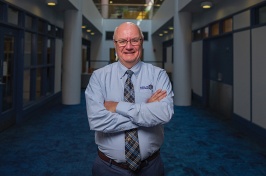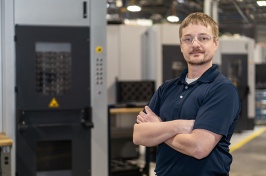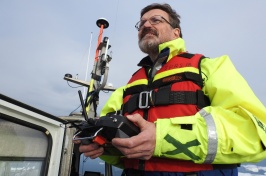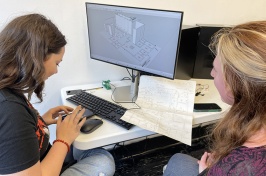Final Flight of Shuttle Atlantis Closes Chapter on UNH Space Science History

Caption: The Holsteins at UNH's Fairchild Dairy Research and Teaching Center are eager to meet visitors at the UNH Open Barn June 18, 2011, hosted by UNH and Granite State Dairy Promotion. Credit: Drew Conroy
Editors and reporters: Mark McConnell can be reached (603) 862-2047 or mark.mcconnell@unh.edu.
DURHAM, N.H. – When the Space Shuttle Atlantis lifts off from Florida’s Kennedy Space Center this Friday morning for its final voyage, it will bring to a close the ship’s 27-year flight history, the 30-year run of the shuttle program itself, and a chapter of space science history at the University of New Hampshire.
Space scientists and technicians from the UNH Space Science Center (SSC) were key members of the team that built the Imaging Compton Telescope (COMPTEL) onboard the 17-ton Compton Gamma Ray Observatory (CGRO) that was lofted into space and placed into orbit by Atlantis astronauts back in 1991. The second of NASA’s Great Observatories, at the time the science satellite was the heaviest astrophysical payload ever placed in orbit by a shuttle, and the delicate operation ended up requiring an unplanned spacewalk to fully deploy the observatory.
“The observatory had a high-gain antenna on a deployable boom,” recalls Professor Mark McConnell of the SSC and department of physics and who spent the first 15 years of his career at UNH working on COMPTEL. “But when the shuttle’s robotic arm lifted CGRO out of the payload bay the boom got stuck and two astronauts were sent out to yank it free and deploy the antenna. Had that not been possible, the science mission would have been severely compromised,” McConnell adds.
During its operation from 1991 to 2000, when it was deorbited by NASA, the Compton Gamma Ray Observatory explored the high-energy sky looking at some of the most violent and energetic processes in the universe, including black holes, solar flares, gamma-ray bursts, and pulsars. It also mapped out sites where all of the heavier elements in the periodic table are created, a process known as nucleosynthesis, which is detected by regions of strong radioactive emissions.
Says McConnell, “The universe started out with just hydrogen and helium and everything else came from the interiors of stars and supernovae. That process of creating heavier elements in supernovae in particular generates or creates a lot of radioactivity, and we were able to measure that with COMPTEL.”
That measurement was made possible by the detection of gamma rays from the far reaches of our galaxy. Such detection is only possible above Earth’s atmosphere and by means of large, heavy detectors such as CGRO because gamma rays are highly energetic and require a lot of mass to stop them.
“Plus, there aren’t that many of them out there,” McConnell said, “it’s a very difficult measurement to make.”
The COMPTEL experiment was headed up at UNH by Professor Jack Lockwood until his retirement, at which point Professor James Ryan took over as the principal investigator. SSC scientists and engineers who worked for years on the COMPTEL experiment and who remain at UNH include Ryan, McConnell, John Macri, Stan Ellis, and Tom Milliman.
UNH also had a legacy with the space shuttle Challenger, which performed the very first on-orbit satellite repair for the Solar Maximum Mission (SMM or SolarMax). Launched on February 14, 1980, SolarMax carried several scientific instruments that provided new insights into the nature of solar flares, including a gamma-ray spectrometer experiment led by Edward Chupp, currently professor emeritus at the SSC.
McConnell notes that COMPTEL was the first gamma-ray detector of its kind to fly in space. Over a nine-year period it picked up signals from just two dozen stars in the entire sky.
“So what we need to do is make instruments that are more sensitive and that can probe weaker sources in the sky. If we can get to a point where we’re seeing hundreds or thousands of sources in sky, then we can start doing more science to broaden the understanding of the way the universe works.”
UNH space scientists and engineers are currently working on projects toward that eventual goal. A significant milestone will be reached this summer with a balloon test flight of a small prototype instrument based on what was learned from COMPTEL.
The Fast Compton Telescope or FACTEL for short will be flown out of New Mexico. The principal investigator for FACTEL is Jim Ryan, with McConnell as co-investigator and SSC research assistant professor Peter Bloser, research project engineer Jason Legere, and graduate student Manuel Jullian also involved in the project.
The University of New Hampshire, founded in 1866, is a world-class public research university with the feel of a New England liberal arts college. A land, sea, and space-grant university, UNH is the state's flagship public institution, enrolling 12,200 undergraduate and 2,300 graduate students.
Photograph: A view of the Compton Gamma Ray Observatory being deployed by the robotic arm of the Space Shuttle Atlantis on April 5, 1991. The COMPTEL instrument, developed in part at UNH, is the large dome-shaped object at the center of the CGRO spacecraft.
http://www.eos.unh.edu/newsimage/comptel_gro.jpg.
-30-
Latest News
-
May 15, 2025
-
May 14, 2025
-
May 14, 2025
-
May 6, 2025
-
April 15, 2025

